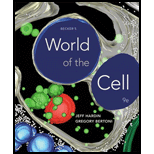
(a)
To explain: The sign of
Introduction: Proteins are one of the most important parts of the living world. Amino acids combine to form different types of proteins. Proteins can be found in three (or four sometimes) structural forms in nature: primary structure; secondary structure; tertiary structure; and quaternary structure. Tertiary and quaternary structures are the functional structures of proteins. Simpler structures combine and fold in a special manner to form the functional proteins. The unfavorable atmosphere around the proteins can lead to the denaturation of the protein.
(b)
To explain: The sign of
Introduction: Proteins are one of the most important parts of the living world. Amino acids combine to form different types of proteins. Proteins can be found in three (or four sometimes) structural forms in nature: primary structure; secondary structure; tertiary structure; and quaternary structure. Tertiary and quaternary structures are the functional structures of proteins. Simpler structures combine and fold in a special manner to form the functional proteins. The unfavorable atmosphere around the proteins can lead to the denaturation of the protein.
(c)
To explain: Whether the contribution of
Introduction: Proteins are one of the most important parts of the living world. Amino acids combine to form different types of proteins. Proteins can be found in three (or four sometimes) structural forms in nature: primary structure; secondary structure; tertiary structure; and quaternary structure. Tertiary and quaternary structures are the functional structures of proteins. Simpler structures combine and fold in a special manner to form the functional proteins. The unfavorable atmosphere around the proteins can lead to the denaturation of the protein.
(d)
To explain: The types of bonds needed to be broken for the unfolding of a protein and why extreme heat and pH causes unfolding of the protein.
Introduction: Proteins are one of the most important parts of the living world. Amino acids combine to form different types of proteins. Proteins can be found in three (or four sometimes) structural forms in nature: primary structure; secondary structure; tertiary structure; and quaternary structure. Tertiary and quaternary structures are the functional structures of proteins. Simpler structures combine and fold in a special manner to form the functional proteins. The unfavorable atmosphere around the proteins can lead to the denaturation of the protein.
Want to see the full answer?
Check out a sample textbook solution
Chapter 5 Solutions
Becker's World of the Cell (9th Edition)
- series of two-point crosses were carried out among six loci (a, b, c, d, e and f), producing the following recombination frequencies. According to the data below, the genes can be placed into how many different linkage groups? Loci a and b Percent Recombination 50 a and c 14 a and d 10 a and e 50 a and f 50 b and c 50 b and d 50 b and e 35 b and f 20 c and d 5 c and e 50 c and f 50 d and e 50 d and f 50 18 e and f Selected Answer: n6 Draw genetic maps for the linkage groups for the data in question #5. Please use the format given below to indicate the genetic distances. Z e.g. Linkage group 1=P____5 mu__Q____12 mu R 38 mu 5 Linkage group 2-X_____3 mu__Y_4 mu sanightarrow_forwardWhat settings would being able to isolate individual bacteria colonies from a mixed bacterial culture be useful?arrow_forwardCan I get a handwritten answer please. I'm having a hard time understanding this process. Thanksarrow_forward
- Biology How many grams of sucrose would you add to 100mL of water to make a 100 mL of 5% (w/v) sucrosesolution?arrow_forwardWhich marker does this DNA 5ʹ AATTGGCAATTGGCAATTGGCAATTGGCAATTGGCAATTGGCAATTGGC 3ʹ show?arrow_forwardThe Z value of LOD for two genes is 4, what does it mean for linkage and inheritance?arrow_forward
- Biology How will you make a 50-ul reaction mixture with 2uM primer DNA using 10 uM primer DNA stocksolution and water?arrow_forwardBiology You’re going to make 1% (w/v) agarose gel in 0.5XTBE buffer 100 ml. How much agarose are you goingto add to 100 ml of buffer? The volume of agaroseis negligible.arrow_forwardBiology How will you make a 50-ul reaction mixture with0.2 mM dNTP using 2-mM dNTP stock solution andwater?arrow_forward
 BiochemistryBiochemistryISBN:9781305577206Author:Reginald H. Garrett, Charles M. GrishamPublisher:Cengage Learning
BiochemistryBiochemistryISBN:9781305577206Author:Reginald H. Garrett, Charles M. GrishamPublisher:Cengage Learning Biology (MindTap Course List)BiologyISBN:9781337392938Author:Eldra Solomon, Charles Martin, Diana W. Martin, Linda R. BergPublisher:Cengage Learning
Biology (MindTap Course List)BiologyISBN:9781337392938Author:Eldra Solomon, Charles Martin, Diana W. Martin, Linda R. BergPublisher:Cengage Learning Biology: The Dynamic Science (MindTap Course List)BiologyISBN:9781305389892Author:Peter J. Russell, Paul E. Hertz, Beverly McMillanPublisher:Cengage Learning
Biology: The Dynamic Science (MindTap Course List)BiologyISBN:9781305389892Author:Peter J. Russell, Paul E. Hertz, Beverly McMillanPublisher:Cengage Learning Human Heredity: Principles and Issues (MindTap Co...BiologyISBN:9781305251052Author:Michael CummingsPublisher:Cengage Learning
Human Heredity: Principles and Issues (MindTap Co...BiologyISBN:9781305251052Author:Michael CummingsPublisher:Cengage Learning Anatomy & PhysiologyBiologyISBN:9781938168130Author:Kelly A. Young, James A. Wise, Peter DeSaix, Dean H. Kruse, Brandon Poe, Eddie Johnson, Jody E. Johnson, Oksana Korol, J. Gordon Betts, Mark WomblePublisher:OpenStax College
Anatomy & PhysiologyBiologyISBN:9781938168130Author:Kelly A. Young, James A. Wise, Peter DeSaix, Dean H. Kruse, Brandon Poe, Eddie Johnson, Jody E. Johnson, Oksana Korol, J. Gordon Betts, Mark WomblePublisher:OpenStax College Biology: The Unity and Diversity of Life (MindTap...BiologyISBN:9781305073951Author:Cecie Starr, Ralph Taggart, Christine Evers, Lisa StarrPublisher:Cengage Learning
Biology: The Unity and Diversity of Life (MindTap...BiologyISBN:9781305073951Author:Cecie Starr, Ralph Taggart, Christine Evers, Lisa StarrPublisher:Cengage Learning





